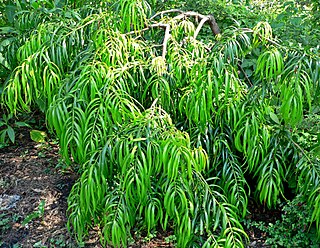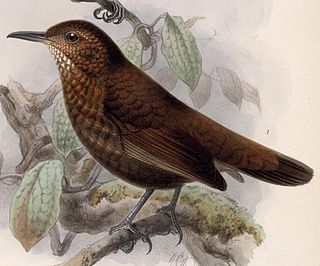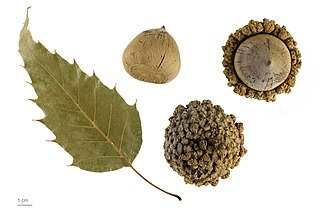
Magnolia macrophylla, the bigleaf magnolia, is a deciduous magnolia native to the southeastern United States and eastern Mexico. This species boasts the largest simple leaf and single flower of any native plant in North America.

Alnus jorullensis, commonly known as Mexican alder, is an evergreen or semi-evergreen alder, native to eastern and southern Mexico, Guatemala, and Honduras. Although previously reported from the Andes, further collections showed these to be the similar species A. acuminata, commonly found in South America.

The pale-billed woodpecker is a species of bird in subfamily Picinae of the woodpecker family Picidae. It is found from Mexico to Panama.

Ostrya virginiana, the American hophornbeam, is a species of Ostrya native to eastern North America, from Nova Scotia west to southern Manitoba and eastern Wyoming, southeast to northern Florida and southwest to eastern Texas. Populations from Mexico and Central America are also regarded as the same species, although some authors prefer to separate them as a distinct species, Ostrya guatemalensis. Other names include eastern hophornbeam, hardhack, ironwood, and leverwood.

Abies guatemalensis, the Guatemalan fir or pinabete, is an evergreen tree native to Central America and is the southernmost member of the genus Abies being spread to the south lower than 14° N. Its range is from southern Mexico in the north to Honduras and El Salvador in the south. It is a warm-loving and moisture-loving tree of the tropical mountain coniferous and mixed cloud forests of these countries. The Guatemalan fir is an almost completely non-frost-resistant tree. Due to logging and loss of habitat, the tree is considered threatened and is protected in CITES Appendix I.

The emerald-chinned hummingbird is a species of hummingbird in the "emeralds", tribe Trochilini of subfamily Trochilinae. It is found in El Salvador, Guatemala, Honduras, Mexico, and Nicaragua.

Podocarpus matudae is a species of conifer in the family Podocarpaceae. It is found in Guatemala, El Salvador, Honduras and Mexico.

The white-bellied chachalaca is a species of bird in the family Cracidae, the chachalacas, guans, and curassows. It is found in El Salvador, Guatemala, Honduras, Mexico, and Nicaragua.

Plectrohyla guatemalensis, also known as the Guatemala spikethumb frog, is a species of frog in the family Hylidae. It occurs in the highlands of the Sierra Madre from southeastern Chiapas, Mexico, and eastward through the central and southwestern highlands of Guatemala to northwestern El Salvador as well as the Sierra de Nombre de Dios in north-central Honduras. It might be a composite of more than one species.

The bushy-crested jay is a species of bird in the family Corvidae. It is found in Central America, where its natural habitats are subtropical or tropical moist montane forests and heavily degraded former forest. There are two subspecies, C. m. melanocyaneus which is found in Guatemala and southern El Salvador, and C. m. chavezi from Honduras and northeastern Nicaragua.

The scaly-throated leaftosser is a species of bird in subfamily Sclerurinae, the leaftossers and miners, of the ovenbird family Furnariidae. It is found in Mexico, every Central American country except El Salvador, and in Colombia and Ecuador.
Magnolia yoroconte is a species of tree in the family Magnoliaceae. It is found in Guatemala, Belize and Honduras.

Quercus skinneri is a species of oak. It is found in Mexico, Guatemala, Honduras, and El Salvador. It is threatened by habitat loss.

Quercus castanea is a species of oak tree. It is widespread across much of Mexico, from Sonora to Chiapas, and in Guatemala, El Salvador, and Honduras.

The Sierra Madre de Chiapas moist forests is a tropical moist broadleaf forest ecoregion in southern Mexico and southern Guatemala, extending into the northwestern corner of El Salvador.
Magnolia mexicana, the Mexican magnolia, is a species of magnolia that is found in parts of Mexico, Guatemala and Honduras. The flower is known in parts of Mexico as yolloxochitl, an Aztec word that loosely translates to heart-shaped flower. The Mexican magnolia, often described as having a strong beautiful scent, has been used throughout the years for its medicinal properties, as it is said to have similar compounds to that of the Digitalis medication.

Carpinus tropicalis is a species of tree native to central and southern Mexico, Guatemala, El Salvador, Honduras, and Nicaragua.

Quercus segoviensis is a species of oak native to southern Mexico and northern Central America. It is commonly known as k’antulán.

Cornus disciflora is a species of flowering plant native to Mexico and Central America.
Magnolia sororum is a species of flowering plant in the family Magnoliaceae. It is commonly known as vaco. It is native to the mountain forests of Costa Rica and western Panama, and may range into Nicaragua.

















